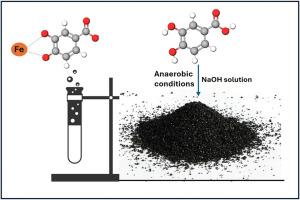3,4-二羟基苯甲酸在不同氧化还原和碱性条件下对铁的溶出
IF 8.1
2区 环境科学与生态学
Q1 ENVIRONMENTAL SCIENCES
引用次数: 0
摘要
各种无机工业副产品,如铁矾渣(FS),有潜力用作二次材料,如建筑或金属回收中的胶凝粘合剂。然而,这些副产物的溶解过程和化学稳定性往往阻碍了它们的利用。特别是,它们在不同化学条件下的行为是复杂的,而且还没有被很好地理解。本研究考察了1 mM浓度的3,4-二羟基苯甲酸(DHBA)在碱性pH为12-14的条件下对FS氧化还原化学和溶解的影响。实验结果表明,在pH值为14的低氧条件下,DHBA对铁的溶解有4倍的促进作用。氧化还原电位测量结果表明,pH值为14时FS + DHBA在厌氧条件下表现出极低的负电位,表明溶液中存在Fe(II)。液相1H NMR显示在pH值13 ~ 14的条件下,Fe(II)/Fe(III)和DHBA配体形成可溶性配合物。XPS数据表明,DHBA通过阻止阳离子在FS表面的积累,在增加溶解中起着至关重要的作用。因此,这些结果为FS、DHBA和环境条件之间的复杂相互作用提供了有价值的信息,并强调了可能提高工业副产品价值的新方法。本文章由计算机程序翻译,如有差异,请以英文原文为准。

Iron dissolution from fayalitic slag with 3,4-dihydroxybenzoic acid under different redox and alkaline conditions
Various inorganic industrial by-products, such as fayalite slag (FS), have potential to be used as secondary materials, such as cementitious binders in construction or in metal recovery. However, the dissolution processes and chemical stability of these by-products often inhibit their utilization. In particular, their behavior under diverse chemical conditions is complex and not well understood. This study investigates the impact of 3,4-dihydroxybenzoic acid (DHBA) with 1 mM concentration on the redox chemistry and dissolution of FS within the alkaline pH range of 12–14 under anaerobic and aerobic conditions. Experimental results show that DHBA provided ∼4x enhancement for dissolution of iron under low oxygen conditions at pH 14. The redox potential measurements reveal that FS + DHBA at pH 14 exhibits very low and negative potentials at anaerobic conditions, indicating the presence of Fe(II) in solution. Liquid-state 1H NMR spectroscopy shows formation of soluble complexes with Fe(II)/Fe(III) and DHBA ligand at pH values 13–14. The XPS data demonstrate that DHBA plays a vital role in increasing dissolution by preventing cations from accumulating on the FS surface. These results, therefore, provide valuable information about the complex interactions between FS, DHBA, and environmental conditions, and highlight new potential approaches that could improve the possibilities to valorize industrial by-products.
求助全文
通过发布文献求助,成功后即可免费获取论文全文。
去求助
来源期刊

Chemosphere
环境科学-环境科学
CiteScore
15.80
自引率
8.00%
发文量
4975
审稿时长
3.4 months
期刊介绍:
Chemosphere, being an international multidisciplinary journal, is dedicated to publishing original communications and review articles on chemicals in the environment. The scope covers a wide range of topics, including the identification, quantification, behavior, fate, toxicology, treatment, and remediation of chemicals in the bio-, hydro-, litho-, and atmosphere, ensuring the broad dissemination of research in this field.
 求助内容:
求助内容: 应助结果提醒方式:
应助结果提醒方式:


